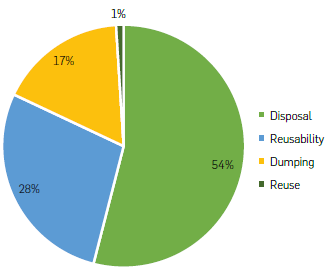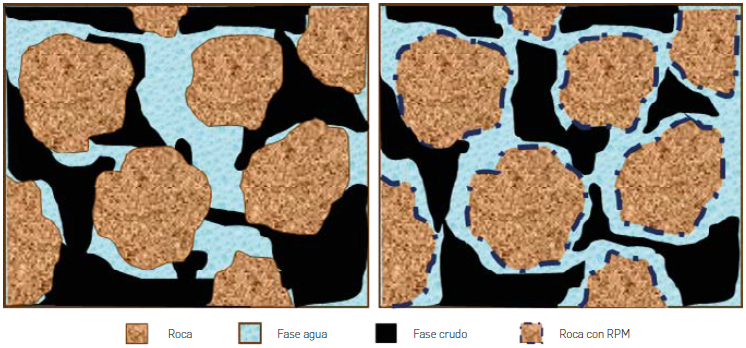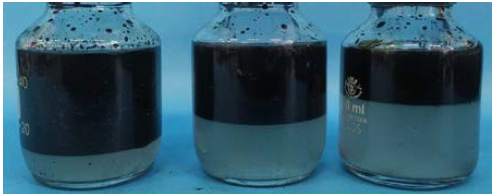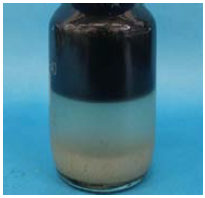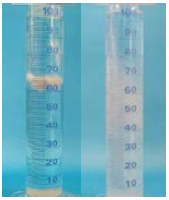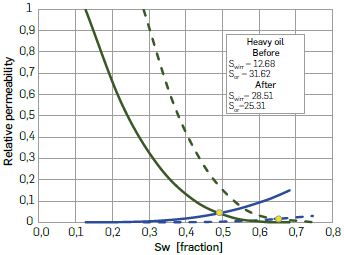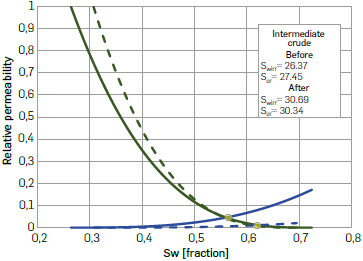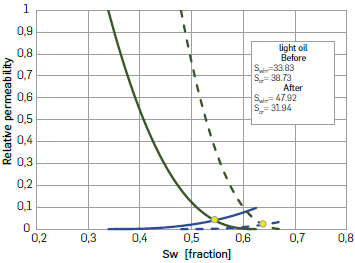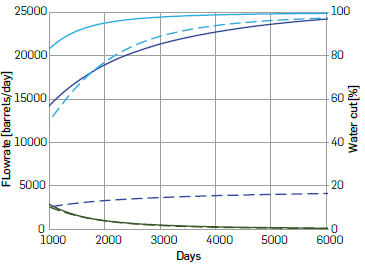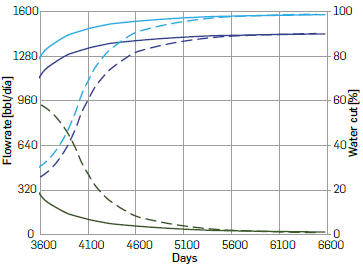ABSTRACT
The management of produced water is a significant environmental challenge, particularly considering the goal to achieve 'Water Neutrality' by 2045, which requires the entire elimination of discharges into water bodies. In Colombia, discharged water currently accounts for over 30% of total water production, approximately 80 million m3, which adversely affect various ecosystems. Moreover, the economic implications are substantial, as each barrel of produced water represents a significant quantity of unextracted oil, impacting the fields' profitability. To address this issue, various stimulation methods have been used to mitigate water production. This study is intended to assess the efficacy of these techniques in reducing water production and improving environmental management.
The Universidad Industrial de Santander, through its specialized services to the hydrocarbon industry, has conducted numerous assessments of relative permeability modifier (RPM) treatments across diverse scenarios and conditions. These evaluations have revealed high reduction in water permeabilities of up to 90%, effectively curbing water contributions from producer wells. This approach not only yields tangible benefits for companies by averting treatment costs, but also translates into environmental benefits through reduced water discharge.
In this study, we leverage this expertise to assess the potential impact of RPM treatments on water production. By analyzing changes in relative permeability curves via reservoir simulation, we aim to estimate the prospective decrease in water production and, consequently, the reduction in oil industry discharges in Colombia prior to a widespread implementation of this technique.
KEYWORDS:
Relative Permeability Modifiers; production water discharges
RESUMEN
La gestión del agua producida presenta un desafío ambiental significativo, particularmente a la luz del objetivo de lograr la 'Agua Nutralidad' para el año 2045, lo que requiere la eliminación completa de las descargas en cuerpos de agua. En Colombia, el agua descargada representa actualmente más del 30% de la producción total de agua, aproximadamente 80 millones de m3, afectando adversamente a diversos ecosistemas. Además, las implicaciones económicas son sustanciales, ya que cada barril de agua producida representa una cantidad notable de petróleo no extraído, impactando la rentabilidad del campo. Para abordar este problema, se han empleado varios métodos de estimulación para mitigar la producción de agua. Este estudio tiene como objetivo evaluar la eficacia de estas técnicas en la reducción de la producción de agua y la mejora de la gestión ambiental.
La Universidad Industrial de Santander, a través de sus servicios especializados para la industria de hidrocarburos, ha realizado numerosas evaluaciones de tratamientos modificadores de permeabilidad relativa (RPM) en diversos escenarios y condiciones, Estas evaluaciones han revelado reducciones notables en las permeabilidades al agua de hasta un 90%, frenando eficazmente las contribuciones de agua en los pozos de producción. Este enfoque no solo produce beneficios tangibles para las empresas al evitar costos de tratamiento, sino que también se traduce en ventajas ambientales a través de la reducción de la descarga de agua.
En este estudio, aprovechamos esta experiencia para evaluar el impacto potencial de los tratamientos RPM en la producción de agua. Mediante el análisis de los cambios en las curvas de permeabilidad relativa a través de simulación de yacimientos, buscamos estimar la posible disminución en la producción de agua y, consecuentemente, la reducción en las descargas de la industria petrolera en Colombia antes de la implementación generalizada de esta técnica.
PALABRAS CLAVE:
Modificadores de permeabilidad relativa; vertimientos de aguas de producción
INTRODUCTION
In Colombia, the current ratio of production water to oil equivalent stands at 11 barrels per barrel, resulting in a substantial volume of 430.55 million cubic meters of water produced in 2022 by just one company. This imposes significant environmental and financial burdens. Long-term Colombian policies aim to achieve "Water Neutrality", targeting a comprehensive reduction in discharges from the hydrocarbon industry, which totaled 80.3 million meters in 2022, a 23% increase vis-a-vis 2021 figures (Ecopetrol S.A., 2022Ecopetrol. Portal, Eficiencia operativa en el manejo del agua. [Citado 10/06/2023]. https://www.ecopetrol.com.co/wps/portal/Home/sostecnibilidad/ambiental/gestion-integral-del-agua/manejo-agua
https://www.ecopetrol.com.co/wps/portal/...
). Achieving water neutrality means establishing a balance between the water a company requires for its operations, and implementing actions that alleviate pressure on this resource, which implies replenishing 100% of the water consumed in facilities through compensatory projects in watersheds.
Furthermore, for oil companies, the management of produced water poses a significant economic challenge, as it can often limit well production due to the high volumes of water that are difficult to handle. Figure 1 illustrates the distribution of production water disposal methods in the Colombian Oil Company - ECOPETROL. It is evident that, despite most of the produced water being either reinjected into disposal wells or reutilized for recovery purposes, approximately 17% is still being discharged into water sources, based solely on Ecopetrol data.
Reducing discharges requires expanding disposal well capacity, promoting produced water reutilization projects, or diversifying its applications beyond the oil and gas sector. Discharging into surface water bodies poses environmental risks due to high levels of total dissolved solids, fats, oils, heavy metals such as Barium and Strontium (with elevated levels of radioactivity) (Prada, 2021Prada, A. (2021). Revisión de las tecnologías para el tratamiento de aguas de producción petrolera para su aprovechamiento en el riego de cultivos. [Monografía, Fundación Universidad de América]. https://repository.uamerica.edu.co/bitstream/20.500.11839/8396/1/823171-2021-I-GA.pdf
https://repository.uamerica.edu.co/bitst...
), dissolved gases including H2S, CO2, O2, various anions, cations, and microorganisms (Mesa et al., 2018Mesa, S. L., Orjuela, J. M., Ramírez, A. T. O., & Herrera, J. A. S. (2018). Revisión del panorama actual del manejo de agua de producción en la industria petrolera colombiana. Gestión y Ambiente, 21(1), 87-98. https://doi.org/10.15446/ga.v21n1.69792
https://doi.org/10.15446/ga.v21n1.69792...
). In aquatic ecosystems, the presence of external agents and/or contaminants causes changes to the physical and chemical characteristics of water. These changes can directly affect the composition and distribution of aquatic communities. While aquatic organisms exposed to toxic substances respond individually, the effects are evident at population, community, and ecosystem levels. The magnitude of these changes primarily depends on the duration, intensity, and nature of the disturbance, as well as the initial conditions of the aquatic ecosystem (Vera et al., 2011Vera-Parra, N. F., Marciales-Caro, L. J., Otero-Paternina, A. M., Cruz-Casallas, P. E., & Velasco-Santamaría, Y. M. (2011). Impacto del agua asociada a la producción de una explotación petrolera sobre la comunidad fitoperifítica del rio Acacias (Meta, Colombia) durante la temporada de lluvias. Orinoquia, 15(1), 31-40. https://dialnet.unirioja.es/descarga/articulo/5441072.pdf
https://dialnet.unirioja.es/descarga/art...
).
This paper investigates how water control techniques, particularly relative permeability modifiers (RPM), contribute to reducing water production at the source, thereby decreasing the volume requiring disposal. Moreover, produced water significantly affects field profitability, as producing a barrel of water often demands as much or more energy than producing an equivalent volume of oil, frequently resulting in the loss of potential oil reserves (Peano et al., 2007Peano, J., Ramirez, R., Eoff, L., & Dalrymple, D. (2007, October). Reducing Water Production from Fractured Wells in the Cuenca de Burgos Field of Mexico. In ACIPET
XII
Technical Colombian Petroleum Congress, Bogota, Colombia (pp. 23-26). https://www.researchgate.net/publication/241787765_Conformance_While_Fracturing_Technology_Used_to_Reduce_Water_Production_in_North_Mexico
https://www.researchgate.net/publication...
). Consequently, various technologies have been developed to minimize these costs and enhance reservoir exploitation efficiency. This study explores these technologies with a focus on mitigating the environmental impacts of water discharges.
2 THEORICAL FRAMEWORK
The escalation of water production in oil wells is an inevitable consequence of field maturation, making water control techniques increasingly appealing (Wang et al, 2011Wang, J., Zhu, X., Guo, H., Gong, X., & Hu, J. (2011). Synthesis and behavior evaluation of a relative permeability modifier. Journal of petroleum science and engineering, 80(1), 69-74. https://doi.org/10.1016/j.petrol.2011.10.013.
https://doi.org/10.1016/j.petrol.2011.10...
). These techniques comprise a series of chemical methods designed to curb excessive water production. Typically, they involve water-soluble polymeric systems with hydrophilic properties that adhere to the rock surface upon contact (Ortega, 2015; Barrufet & Ali, 1994Barrufet, M. A., & Ali, L. (1994, April). Modification of relative permeability curves by polymer adsorption. In SPE Latin America and Caribbean Petroleum Engineering Conference (pp. SPE-27015). SPE. https://doi.org/10.2118/27015-MS
https://doi.org/10.2118/27015-MS...
; Al- Azmi et al., 2023; Salman et al., 2015; Wang et al., 2011Wang, J., Zhu, X., Guo, H., Gong, X., & Hu, J. (2011). Synthesis and behavior evaluation of a relative permeability modifier. Journal of petroleum science and engineering, 80(1), 69-74. https://doi.org/10.1016/j.petrol.2011.10.013.
https://doi.org/10.1016/j.petrol.2011.10...
; Alfarge et al., 2017Alfarge, D. K., Wei, M., & Bai, B. (2017). Numerical simulation study of factors affecting relative permeability modification for water-shutoff treatments. Fuel, 207, 226239. https://doi.org/10.1016/j.fuel.2017.06.041.
https://doi.org/10.1016/j.fuel.2017.06.0...
).
Relative Permeability Modifiers effectively restrict water flow through the rock by occupying available space within the porous medium, leveraging their affinity for trapping water (Escobar et al., 2004Escobar Acosta, V. D., Sánchez Rosero, O. I., Restrepo, D. P., & Lopera, S. H. (2004). Nueva metodología de laboratorio para evaluar la efectividad de tratamientos de permeabilidad relativa. Energética. https://repositorio.unal.edu.co/bitstream/handle/unal/36331/24002-83980-1-PB.pdf?sequence=1
https://repositorio.unal.edu.co/bitstrea...
). Core flooding experiments typically reveal some degree of damage associated with RPM injection for both fluid phases. However, the disproportionate reduction favoring crude oil flow is what gives this technology its practical utility. Nevertheless, there is a risk of causing significant damage that, when applied in the field, could give rise to more problems than solutions. Hence, selecting a rock sample that most accurately represents the formation becomes a critical parameter. Furthermore, in highly heterogeneous zones, there is a possibility of plugging small pore throats, which could considerably restrict fluid flow.
According to Kabir (2001), RPMs can be classified into two polymer types: polymeric gels and non-gelled polymers. Polymeric gels include most polyacrylamide (PAM) gels and biopolymers, while non-gel relative permeability modifying polymers consist in simple linear polymers such as polyacrylamide and polysaccharide (a non-ionic biopolymer) (Al-Taq et al., 2023). The latter aligns primarily with those examined and referenced in the current study. Polymer solutions and gels are commonly used to manage excessive water production in oil and gas wells, as they reduce water permeability more significantly than oil or gas flow (Alfarge et al., 2017Alfarge, D. K., Wei, M., & Bai, B. (2017). Numerical simulation study of factors affecting relative permeability modification for water-shutoff treatments. Fuel, 207, 226239. https://doi.org/10.1016/j.fuel.2017.06.041.
https://doi.org/10.1016/j.fuel.2017.06.0...
).
The RPM is a water-soluble, hydrophobic polymer specifically engineered to reduce water production in oil and gas wells. This polymer adheres to the pore surfaces of the rock (throat walls), where its hydrophilic groups selectively impede water flow through the porous media while maintaining hydrocarbon permeability (Figure 2).
The adsorption of RPM polymer onto the rock surface significantly alters fluid distribution within the porous medium. This process enhances the rock's water-wetting characteristics, causing water to relocate towards pore walls and throats. Consequently, it modifies the irreducible water saturation-typically increasing it-and impacts water mobility. These changes create a more friendly scenario for crude oil flow in the treated near-wellbore region. As depicted in Figure 2, a rock exhibiting mixed wettability will adsorb Relative Permeability Modifier onto its surface, resulting in an additional impediment to flow due to polymer adsorption. However, this impediment is more pronounced for the water phase flow due to the chemical properties of the RPM. The polymer, upon adhering to the rock surface, serves three primary functions:
Reduction of flow area: Polymer adsorption on the rock surface decreases the cross-sectional area available for fluid flow.
Wettability modification: The polymer's hydrophilic nature alters the rock surface wettability, impeding water phase movement through the porous medium (Serigth et al., 2002).
Surface smoothing: The adsorbed polymer layer reduces pore throat roughness, facilitating the flow of the non-wetting crude phase. This creates a water film that enables oil to glide along the pore's center, explaining the less significant reduction in crude phase mobility compared to the water phase (Prado et al., 2009Prado, M., Reyna, M., Rauseo, O., & Ferreira, I. (2009, May). Evaluation of the effect of oil viscosity on the disproportionate permeability reduction of a polymeric gel used for controlling excess water production. In SPE (pp. SPE-121499). SPE. https://doi.org/10.2118/121499-MS
https://doi.org/10.2118/121499-MS... ).
Several authors pinpoint the "wall effect" as the primary mechanism through which RPMs function, serving as the foundation for the alteration of relative permeability. Wall effects, resulting from a layer of adsorbed polymer on pore surfaces, demonstrate that residual oil droplets in the center of pores can significantly reduce the effective width of water channels during flooding. In contrast, this restriction may not occur during oil flooding. Consequently, for a given thickness of adsorbed polymer layer, the reduction in water permeability during water flooding is more pronounced than the reduction in oil permeability during oil flooding Furthermore, the adsorption of RPM polymers changes the wettability of the rock, increasing its affinity for water and subsequently affecting the capillary pressure (Abbas et al., 2023). Moreover, other authors suggest that gravitational effects, lubrication, swelling, thinning, heterogeneity, and adsorption collectively contribute to the RPM's efficacy.
This study was undertaken to explore potential environmental benefits of routine stimulation techniques in the oil industry, seeking to highlight a more positive aspect of the sector and foster better relations with society. Various techniques were evaluated to identify those with favorable environmental implications. Relative permeability modifier treatments emerged as having a potentially positive environmental impact. With water discharge practices still in use, reducing water production at the source could correlate to a decrease in such discharges.
3 EXPERIMENTAL DEVELOPMENT
First, a comprehensive compilation of relative permeability modifier treatments was evaluated at the Universidad Industrial de Santander for water control. As the available data was derived from laboratory tests, reservoir simulation was used to scale the phenomenon to well level. The research then progressed to examine the potential impact of alterations in relative permeability curves on water production through reservoir simulation (Botermans et al., 2001Botermans, C. W., van Batenburg, D. W., & Bruining, J. (2001, May). Relative permeability modifiers: myth or reality. In
SPE
European Formation Damage Conference and Exhibition (pp. SPE-68973). SPE. https://doi.org/10.2118/68973-MS.
https://doi.org/10.2118/68973-MS...
; Alfarge et al., 2017Alfarge, D. K., Wei, M., & Bai, B. (2017). Numerical simulation study of factors affecting relative permeability modification for water-shutoff treatments. Fuel, 207, 226239. https://doi.org/10.1016/j.fuel.2017.06.041.
https://doi.org/10.1016/j.fuel.2017.06.0...
).
Finally, the study estimates the volume of water that remains unproduced, correlating this with a reduction in water discharges. Data Collection: over the years, the Universidad Industrial de Santander has collaborated extensively with the Oil & Gas sector, focusing on evaluating the impact of Relative Permeability Modifiers (RPMs) on relative permeability curves. Table 1 summarizes numerous results from these collaborations, primarily using crude oil from target formations with viscosities ranging from 2 to 400 cP (at reservoir conditions) and API gravities between 9° and 45°. These evaluations typically involve preliminary processes leading to the rock-fluid interaction stage (core flooding). Various tests are conducted to assess the chemical agent effects on formation fluids at a static level, including visual wettability, compatibility, interfacial tension, detergency, and contact angle assessments, among others. Figure 3 outlines a standardized protocol for selecting an RPM treatment. This protocol progresses from the initial characterization of rock, fluids, and chemicals to assessing fluid-fluid interaction. This approach helps identify potential damage scenarios arising from the interaction between the treatment mixture and formation fluids. Subsequent tests are conducted in relevant environments to evaluate fluid-rock interaction and the impacts of the treatment itself.
In cases where promising initial results are observed, the experimental protocol typically extends to include the injection of additional pore volumes of water. This extended testing phase can involve the injection of up to 200 pore volumes of water. The primary objective of this prolonged injection process is to assess the durability and adhesion strength of the RPM to the rock surface, understanding the long-term behavior of the RPM that helps in refining treatment formulations and application procedures for better field results [Cardenas et al., 2024Cardenas, J. C., Ariza, E., Torres, R., Patiño, J. C., Jaimes, M. G., Prada, A.....& Galvis, H. (2024, February). Nano Relative Permeability Modifier (NanoRPM): A Promising Solution for Water Control in Colombian Oilfields. In
SPE
International Conference and Exhibition on Formation Damage Control (p. D021S009R001). SPE. https://doi.org/10.2118/217925-MS.
https://doi.org/10.2118/217925-MS...
; Díaz et al.,2009; Rodriguez et al., 2011Rodriguez, E., Duarte, C., Martinez, W., León, J., Ortega, A., Lastre, M.....& Navarro, C. (2011, June). Selective Stimulation and Water Control in High-Water-Cut Wells: Case Histories from Upper Magdalena Valley Basin in Colombia. In
SPE
European Formation Damage Conference and Exhibition (pp. SPE-144803). SPE. https://doi.org/10.2118/144803-MS
https://doi.org/10.2118/144803-MS...
).
A compatibility test is conducted to ensure that the treatment does not generate substances, precipitates, or emulsions that could potentially lead to formation damage when in contact with formation fluids (Figure 4). Detergency tests are performed to confirm the treatment's effectiveness in maintaining cleanliness, ensuring efficient penetration into the formation and easy recovery post-application (Figure 5).
Tests illustrated in Figures 6 and 7 focus on technical evaluations designed to assess the static performance of the fluid intended for use as an RPM. Contact angle measurements provide insights into the affinity of the treated surface (such as the target rock) with the fluid under scrutiny. Additionally, the behavior of formation sand in response to the treatment is evaluated; dispersion in an aqueous environment and agglomeration in an oily environment suggest that the treatment renders the sand predominantly water wet.
Each experiment presented in Table 1 is an outcome of applying the methodology depicted in Figure 3, leading up to a core flooding test conducted under specific pressure and temperature conditions. Consequently, each evaluation requires considerable experimental efforts.
The Residual Resistance Factor (RRF) is a widely referenced parameter in the literature for studying an RPM. Defined in Equation 1, it quantifies the reduction in permeability for a given phase (Al-Taq et al., 2008Al-Taq, A. A., Nasr-El-Din, H. A., Saudi, M. M., & Sierra, L. (2008, February). Potential Damage Due to Relative Permeability Modifiers: Laboratory Studies and A Case History
. In
SPE
International Conference and Exhibition on Formation Damage Control (pp. SPE-112458). SPE. https://doi.org/10.2118/112458-MS
https://doi.org/10.2118/112458-MS...
). In this study, the RRF was used to identify optimal scenarios, characterized by effective permeability reductions greater than 70% for water and less than 45% for crude oil. These favorable scenarios are marked as "Feasible" in Table 1. An RRF of 2 means that the final permeability is reduced by half. The greater the disparity in this measure between the crude oil and water phases, the better the chances of a successful application.
It is noteworthy noting that the performance of these treatments depends on various factors. The absence of positive results for a specific treatment at a given concentration does not necessarily indicate the inefficiency of the fluid. . Rather, it suggests potential for optimization at different concentrations.
Data analyse reveal that out of the thirty-three (33) treatments aimed at modifying the relative permeability and wettability curves of the rock samples, thirteen (13) experiments yielded positive results when evaluated in terms of the Residual Resistance Factors (RRFs) for both phases. The effectiveness of such treatments depends on numerous factors, including the chemical nature of the treatment fluid, its concentration, formulation stability, and viscosity, as well as the characteristics of the formation brine, rock mineralogy, and initial rock wettability conditions.
Consequently, from the initial conception of the treatment, it is crucial to conduct an in-depth study of the formation's characteristics, conditions, and fluids to be evaluated. The relationship between permeability and chemical concentration is fundamental for the successful application of these treatments. This comprehensive approach ensures that the treatment is tailored to the specific geological and fluid properties of the target formation, maximizing the likelihood of achieving the desired permeability changes.
CHANGES IN RELATIVE PERMEABILITY. The effectiveness of the treatment is determined by comparing the effective permeability of each phase before and after the injection of the Relative Permeability Modifier (RPM), quantified by the Residual Resistance Factor (RRF) value for each phase. This method yields the most accurate results.
Using RockFlooding software (developed at the University), relative permeability curves were determined through historical adjustment of pressure differential and crude oil production data over time for the tests with the best RRF scenarios. Three sets of relative permeability curves were selected to represent heavy, intermediate, and light crude oil systems, capturing the diversity of Colombian crude oils.
The results shown in Figures 8, 9, and 10 generally show a rightward shift in the intersection of the relative permeability curves. This shift indicates that the rock has become more water-wet after the application of the RPM treatment. Additionally, the irreducible water saturations increase post-treatment, suggesting that the rock tends to retain more water after the injection of the chemical system.
Figures 3, 4, and 5 illustrate successful systems evaluated for different types of crude oil. The graphs display the original relative permeability curves (solid lines) and the post-treatment curves (dotted lines). The three best results were selected for progression to the simulation phase.
Simulation base cases. Table 2 outlines the simulation base cases designed to assess the impact of relative permeability curve variations on water production levels. To encompass representative conditions across the country, three scenarios with differing permeabilities were proposed, as detailed in Table 2. In all cases, a single well at the center with a drainage radius of 1000 ft was modeled, as illustrated in Figure 11. The simulations were conducted using a radial grid system comprising 25 grid blocks in the radial direction. Each productive layer was represented by a single grid block in the vertical direction.
In 2001, Botermans et al., (2001)Botermans, C. W., van Batenburg, D. W., & Bruining, J. (2001, May). Relative permeability modifiers: myth or reality. In
SPE
European Formation Damage Conference and Exhibition (pp. SPE-68973). SPE. https://doi.org/10.2118/68973-MS.
https://doi.org/10.2118/68973-MS...
, used a commercial simulator to validate the effects of relative permeability modifier (RPM) treatments at the reservoir level. Their methodology involved initially fine-tuning the relative permeability curves through core flooding tests, followed by refining these curves and adjusting RPM polymer adsorption isotherms. This process enabled them to accurately replicate the behavior of the fluid-rock interface under the influence of RPM treatment. More recent studies have further explored RPM-type treatments using reservoir simulation. Alfarge et al. (2017)Alfarge, D. K., Wei, M., & Bai, B. (2017). Numerical simulation study of factors affecting relative permeability modification for water-shutoff treatments. Fuel, 207, 226239. https://doi.org/10.1016/j.fuel.2017.06.041.
https://doi.org/10.1016/j.fuel.2017.06.0...
investigated the primary factors influencing the field-level performance of RPMs, while Ahmed et al. (2023)Ahmed, A. A., Saaid, I. M., Sambo, C., Shafian, S. R. M., & Hamza, M. F. (2023). Experimental investigation and numerical simulation of relative permeability modifiers during water shut-off. Geoenergy Science and Engineering, 230, 212095.. https://doi.org/10.1016/j.geoen.2023.212095.
https://doi.org/10.1016/j.geoen.2023.212...
focused on fitting rheological models for these treatments.
4. RESULTS
For each simulated scenario, two simulations were conducted: one using the baseline relative permeability curves, and another using the curves modified by the RPM treatment, totaling six (6) evaluated cases. Following the approach of Botermans et al., Alfarge et al., and Abbas et al., we used CMG for the simulations. However, unlike previous studies, the methodology for this research utilized a novel approach. Instead of fitting the relative permeability curves twice (based on experimental results and adsorption isotherms), both curves were adjusted simultaneously using a sophisticated computational tool. This innovative method offered two significant advantages: it substantially reduced simulation time and enabled the researchers to employ IMEX modeling to characterize the phenomena as typical black oil.
Figures 12, 13, and 14 illustrate the simulation results. In each graph, the green lines represent daily crude oil production, and the dark blue lines indicate daily water production, both on the primary axis. The water cut is depicted by a light blue line on the secondary axis. Solid lines denote the baseline scenario, while dashed lines represent the RPM-treated scenario. All graphs focus on the simulation segment where the water cut in the base case exceeded 80%, as this typically represents the threshold for applying such treatments due to high water production (surpassing crude oil production by more than tenfold).
The results suggest that favorable laboratory performance, as measured by residual resistance factors for water and crude oil, does not necessarily translate into similar outcomes at the well level. For instance:
Case 1 (Figure 12) exhibits significant reductions in water production without affecting crude oil production significantly.
Case 2 (Figure 13) unexpectedly shows an increase in water production.
Case 3 demonstrates a decrease in water production, albeit to a lesser extent than in Case 1.
Numerous researchers have investigated various factors influencing the outcomes of relative permeability modifier treatments (Salman et al., 2015Salman Hayatullah, M., Ridwan, R., Raihan, R., Meifresia, L., Kurniawan, H., & Napitupulu, B. H. (2015, October). Relative permeability modifier (RPM) as chemical diverter in bullhead matrix acidizing treatment. In
SPE
Asia Pacific Oil and Gas Conference and Exhibition (pp. SPE-176100). SPE. https://doi.org/10.2118/176100-MS.
https://doi.org/10.2118/176100-MS...
; Wang et al.,2011Wang, J., Zhu, X., Guo, H., Gong, X., & Hu, J. (2011). Synthesis and behavior evaluation of a relative permeability modifier. Journal of petroleum science and engineering, 80(1), 69-74. https://doi.org/10.1016/j.petrol.2011.10.013.
https://doi.org/10.1016/j.petrol.2011.10...
). In the present study, conceptual simulation models were developed based on the types of crude oil and rock evaluated in the experimental stage.
The results can be summarized as follows, case 1 demonstrated the most favorable outcome among the evaluated scenarios, with reductions in crude oil and water production of 6.93% and 82.02%, respectively. Case 2 unexpectedly exhibited an increase in water production, contrary to the treatment's intended effect. Case 3 showed a moderate improvement, with a 55% reduction in water production. Table 3 illustrates the impact on fluid production for the three cases evaluated, where cumulative production was assessed one year after surpassing the 80% water cut threshold.
5. RESULTS ANALYSIS
From a technical perspective, Relative Permeability Modifiers represent a sophisticated technology for effectively controlling excessive water production through multiple mechanisms, as previously discussed. This control not only enhances crude oil production but also generates significant economic benefits. The advantages of RPM treatments go beyond production optimization by reducing produced water, as these treatments can alleviate several production-related challenges, including fines migration, scale deposits, corrosion and water treatment requirements. These improvements lead to economic, operational, and technical advantages across the production process.
Some studies have reported remarkable results from RPM treatments. For instance, one report indicated a reduction of 26 million barrels of produced water during the treatment application period, averaging a decrease of 274,000 barrels of water production per well (Portwood et al., 2005Portwood, J. T. (2005, April). The Kansas Arbuckle formation: performance evaluation and lessons learned from more than 200 polymer-gel water-shutoff treatments. In SPE
Oklahoma City Oil and Gas Symposium/Production and Operations Symposium (pp. SPE-94096). SPE. https://doi.org/10.2118/94096-MS.
https://doi.org/10.2118/94096-MS...
).
However, the translation of laboratory success to field application involves certain challenges. In the comprehensive evaluation conducted at Universidad Industrial de Santander, only 13 out of 33 chemicals tested achieved favorable results based on Residual Resistance Factor criteria. When these laboratory-successful treatments were simulated in a well model, the outcome diverged from laboratory observations. This discrepancy underlines that the success of RPM treatments in field applications is influenced by factors beyond changes in relative permeability curves, such as the nature of crude oil and specific reservoir characteristics. This misalignment between laboratory results and field simulations underscores the multifaceted nature of successful RPM implementation in real-world scenarios.
The transition from laboratory experiments to field-scale simulations introduces significant changes in flow dynamics. While laboratory tests typically involve linear flow with constant velocities throughout the sample, field simulations must account for radial flow, where velocities vary with the cross-sectional area. This shift in the flow regime has several important implications. Additionally, the pressure drop across a core plug in laboratory tests is relatively small compared to the pressure differential across the entire drainage radius in a field scenario. The this difference amplifies the effect of capillary forces in well models, potentially altering fluid behavior compared to laboratory observations. Also, in field-scale applications introduce complexities not present in controlled laboratory environments, such as heterogeneity in rock properties across the reservoir, well integrity issues, operational and logistical challenges, and social and environmental factors
As previously discussed, Colombia's oil industry discharges 80.3 million cubic meters of water into surface water bodies annually, with approximately 81.3% (65.28 million cubic meters) being production water from Ecopetrol alone. The potential impact of Relative Permeability Modifiers (RPMs) on this water production is significant. Based on our findings, RPMs could potentially reduce total produced water by 55% to 82.02%. In optimal conditions, this reduction could be maintained between 35.9 and 53.53 million cubic meters of water annually.
These projections are based on several key assumptions. First, the allocation of produced water to other destinations (disposal, reuse, and reutilization) remains constant. Second, all reductions in water production directly prevent discharge into the environment. If these conditions are met, the implementation of the RPM technology could have substantial positive effects on local ecosystems and water resources. Further, reduced water production could lead to lower operational costs associated to water handling and treatment, as well as improved oil recovery and extended well life.
However, it is crucial to note that this projection represents a best-case scenario, contingent on optimal performance of RPM treatments across all applicable wells. As demonstrated in our simulations, the effectiveness of RPM treatments can vary significantly based on reservoir characteristics and crude oil properties. Achieving this level of water reduction would require widespread adoption of RPM technology, plus a successful application across diverse field conditions.
While these projections are promising, they also highlight the need for further research and development of the RPM technology. Additional field trials and long-term studies are necessary to validate the sustained effectiveness of RPM treatments at scale. The potential for substantial water conservation underscores the importance of comprehensive field implementation strategies to maximize the environmental and economic benefits of these treatments in Colombia's oil industry. The application of the RPM technology is an excellent opportunity for Colombia's oil industry to reduce its environmental footprint while potentially improving operational efficiency. However, realizing these benefits will require continued investment in research, careful implementation, and ongoing monitoring of treatment effectiveness across varied field conditions.
CONCLUSIONS
Excessive water production in oil fields presents significant economic and environmental challenges. It not only leads to reduced oil output and increased costs associated to treating and disposing of produced water, but also exacerbates environmental impacts through the discharge of water into surface streams. In this context, Relative Permeability Modifier (RPM) treatments emerge as a crucial strategy for managing water production, offering the potential to substantially mitigate these adverse effects.
A comprehensive analysis of various experimental tests, including fluid-fluid and rock-fluid interaction assessments through core flooding tests, led to the identification of three fluids with the most promising outcomes. Relative permeability curves were established both before and after the application of RPM treatments. Subsequent simulations based on these curves revealed a significant reduction in produced water, ranging from 55% to an impressive 82%.
Drawing upon the extensive expertise of Universidad Industrial de Santander in evaluating RPM treatments and conducting associated simulations, it is estimated that the widespread application of such treatments could lead to a substantial reduction in produced water volume. The projected decrease ranges between 35.9 and 53.53 million cubic meters annually. However, it should be noted that this projection represents an optimistic scenario, predicated on achieving a 100 percent success rate in large-scale operations implementing these treatments.
ACKNOWLEDGEMENTS
The authors of this research express their gratitude to the Laboratory of Petrophysical Analysis and Formation Damage of the Computer Tomography for Reservoir Characterization Research Group of the Universidad Industrial de Santander.
REFERENCES
- Ahmed, A. A., Saaid, I. M., Sambo, C., Shafian, S. R. M., & Hamza, M. F. (2023). Experimental investigation and numerical simulation of relative permeability modifiers during water shut-off. Geoenergy Science and Engineering, 230, 212095.. https://doi.org/10.1016/j.geoen.2023.212095
» https://doi.org/10.1016/j.geoen.2023.212095 - Alfarge, D. K., Wei, M., & Bai, B. (2017). Numerical simulation study of factors affecting relative permeability modification for water-shutoff treatments. Fuel, 207, 226239. https://doi.org/10.1016/j.fuel.2017.06.041
» https://doi.org/10.1016/j.fuel.2017.06.041 - Al-Azmi, A. A., Abdul-Aziz, W. J., & Al-Yaqout, T. A. (2023, June). Polymer Water Shut-Off Design and Efficiency Evaluation Based on Experimental Studies. In SPE International Conference on Oilfield Chemistry (p. D021S008R005). SPE. https://doi.org/10.2118/213875-MS
» https://doi.org/10.2118/213875-MS - Al-Taq, A., Alrustum, A., Alfakher, B., & Al-Ibrahim, H. (2021, December). Relative Permeability Modifiers as a Chemical Means to Control Water Production in Oil and Gas Reservoirs. In SPE Middle East Oil and Gas Show and Conference (p. D041S044R006). SPE. https://doi.org/10.2118/204692-MS
» https://doi.org/10.2118/204692-MS - Al-Taq, A. A., Nasr-El-Din, H. A., Saudi, M. M., & Sierra, L. (2008, February). Potential Damage Due to Relative Permeability Modifiers: Laboratory Studies and A Case History . In SPE International Conference and Exhibition on Formation Damage Control (pp. SPE-112458). SPE. https://doi.org/10.2118/112458-MS
» https://doi.org/10.2118/112458-MS - Barrufet, M. A., & Ali, L. (1994, April). Modification of relative permeability curves by polymer adsorption. In SPE Latin America and Caribbean Petroleum Engineering Conference (pp. SPE-27015). SPE. https://doi.org/10.2118/27015-MS
» https://doi.org/10.2118/27015-MS - Botermans, C. W., van Batenburg, D. W., & Bruining, J. (2001, May). Relative permeability modifiers: myth or reality. In SPE European Formation Damage Conference and Exhibition (pp. SPE-68973). SPE. https://doi.org/10.2118/68973-MS
» https://doi.org/10.2118/68973-MS - Cardenas, J. C., Ariza, E., Torres, R., Patiño, J. C., Jaimes, M. G., Prada, A.....& Galvis, H. (2024, February). Nano Relative Permeability Modifier (NanoRPM): A Promising Solution for Water Control in Colombian Oilfields. In SPE International Conference and Exhibition on Formation Damage Control (p. D021S009R001). SPE. https://doi.org/10.2118/217925-MS
» https://doi.org/10.2118/217925-MS - Diaz, G., Castillo, P., Villa, K., Sanchez, L., Mucci, M., Robles, J..... & Peacock, H. (2009, May). Fracture conformance treatments using RPM: efficiency and durability evaluation. In SPE Latin America and Caribbean Petroleum Engineering Conference (pp. SPE-122913). SPE. https://doi.org/10.2118/122913-MS
» https://doi.org/10.2118/122913-MS - Ecopetrol. Portal, Eficiencia operativa en el manejo del agua [Citado 10/06/2023]. https://www.ecopetrol.com.co/wps/portal/Home/sostecnibilidad/ambiental/gestion-integral-del-agua/manejo-agua
» https://www.ecopetrol.com.co/wps/portal/Home/sostecnibilidad/ambiental/gestion-integral-del-agua/manejo-agua - Escobar Acosta, V. D., Sánchez Rosero, O. I., Restrepo, D. P., & Lopera, S. H. (2004). Nueva metodología de laboratorio para evaluar la efectividad de tratamientos de permeabilidad relativa. Energética. https://repositorio.unal.edu.co/bitstream/handle/unal/36331/24002-83980-1-PB.pdf?sequence=1
» https://repositorio.unal.edu.co/bitstream/handle/unal/36331/24002-83980-1-PB.pdf?sequence=1 - Grupo Ecopetrol. (2022). Informe Integrado de Gestión (2022). https://files.ecopetrol.com.co/web/esp/cargas/ecopetrol-rigs-2022-esp.pdf
» https://files.ecopetrol.com.co/web/esp/cargas/ecopetrol-rigs-2022-esp.pdf - Mesa, S. L., Orjuela, J. M., Ramírez, A. T. O., & Herrera, J. A. S. (2018). Revisión del panorama actual del manejo de agua de producción en la industria petrolera colombiana. Gestión y Ambiente, 21(1), 87-98. https://doi.org/10.15446/ga.v21n1.69792
» https://doi.org/10.15446/ga.v21n1.69792 - Ortega, G. E. Evaluación de un modificador de permeabilidad relativa (MPR), en el medio poroso con crudo extrapesado (Doctoral dissertation). http://saber.ucv.ve/bitstream/10872/15887/1/TRABAJO%20ESPECIAL%20DE%20GRADO.pdf
» http://saber.ucv.ve/bitstream/10872/15887/1/TRABAJO%20ESPECIAL%20DE%20GRADO.pdf - Peano, J., Ramirez, R., Eoff, L., & Dalrymple, D. (2007, October). Reducing Water Production from Fractured Wells in the Cuenca de Burgos Field of Mexico. In ACIPET XII Technical Colombian Petroleum Congress, Bogota, Colombia (pp. 23-26). https://www.researchgate.net/publication/241787765_Conformance_While_Fracturing_Technology_Used_to_Reduce_Water_Production_in_North_Mexico
» https://www.researchgate.net/publication/241787765_Conformance_While_Fracturing_Technology_Used_to_Reduce_Water_Production_in_North_Mexico - Portwood, J. T. (2005, April). The Kansas Arbuckle formation: performance evaluation and lessons learned from more than 200 polymer-gel water-shutoff treatments. In SPE Oklahoma City Oil and Gas Symposium/Production and Operations Symposium (pp. SPE-94096). SPE. https://doi.org/10.2118/94096-MS
» https://doi.org/10.2118/94096-MS - Prada, A. (2021). Revisión de las tecnologías para el tratamiento de aguas de producción petrolera para su aprovechamiento en el riego de cultivos. [Monografía, Fundación Universidad de América]. https://repository.uamerica.edu.co/bitstream/20.500.11839/8396/1/823171-2021-I-GA.pdf
» https://repository.uamerica.edu.co/bitstream/20.500.11839/8396/1/823171-2021-I-GA.pdf - Prado, M., Reyna, M., Rauseo, O., & Ferreira, I. (2009, May). Evaluation of the effect of oil viscosity on the disproportionate permeability reduction of a polymeric gel used for controlling excess water production. In SPE (pp. SPE-121499). SPE. https://doi.org/10.2118/121499-MS
» https://doi.org/10.2118/121499-MS - Rodriguez, E., Duarte, C., Martinez, W., León, J., Ortega, A., Lastre, M.....& Navarro, C. (2011, June). Selective Stimulation and Water Control in High-Water-Cut Wells: Case Histories from Upper Magdalena Valley Basin in Colombia. In SPE European Formation Damage Conference and Exhibition (pp. SPE-144803). SPE. https://doi.org/10.2118/144803-MS
» https://doi.org/10.2118/144803-MS - Salman Hayatullah, M., Ridwan, R., Raihan, R., Meifresia, L., Kurniawan, H., & Napitupulu, B. H. (2015, October). Relative permeability modifier (RPM) as chemical diverter in bullhead matrix acidizing treatment. In SPE Asia Pacific Oil and Gas Conference and Exhibition (pp. SPE-176100). SPE. https://doi.org/10.2118/176100-MS
» https://doi.org/10.2118/176100-MS - Seright, R. S., Liang, J., Lindquist, W. B., & Dunsmuir, J. H. (2002). Characterizing disproportionate permeability reduction using synchrotron X-ray computed microtomography. SPE Reservoir Evaluation & Engineering, 5(05), 355-364. https://doi.org/10.2118/79717-PA
» https://doi.org/10.2118/79717-PA - Vera-Parra, N. F., Marciales-Caro, L. J., Otero-Paternina, A. M., Cruz-Casallas, P. E., & Velasco-Santamaría, Y. M. (2011). Impacto del agua asociada a la producción de una explotación petrolera sobre la comunidad fitoperifítica del rio Acacias (Meta, Colombia) durante la temporada de lluvias. Orinoquia, 15(1), 31-40. https://dialnet.unirioja.es/descarga/articulo/5441072.pdf
» https://dialnet.unirioja.es/descarga/articulo/5441072.pdf - Wang, J., Zhu, X., Guo, H., Gong, X., & Hu, J. (2011). Synthesis and behavior evaluation of a relative permeability modifier. Journal of petroleum science and engineering, 80(1), 69-74. https://doi.org/10.1016/j.petrol.2011.10.013
» https://doi.org/10.1016/j.petrol.2011.10.013
Authors
-
Raúl Andrés Martínez López
Affiliation: Universidad Industrial de Santander, Bucaramanga, Colombia.
ORCID: 0000-0002-5192-9683
E-mail: raulmartinez@correo.uis.edu.co -
Nicolás Santos Santos
Affiliation: Universidad Industrial de Santander, Bucaramanga, Colombia.
ORCID: 0000-0003-1180-8366
E-mail: nicolas@uis.edu.co -
Luis Felipe Carrillo Moreno
Affiliation: Universidad Industrial de Santander, Bucaramanga, Colombia.
ORCID: 0000-0002-9931-0206
E-mail: luis.carrillo@correo.uis.edu.co -
Luis Alejandro Torres Doria
Affiliation: Universidad Industrial de Santander, Bucaramanga, Colombia.
ORCID: 0000-0002-4148-0704
E-mail: luis2188723@correo.uis.edu.co
-
How to cite:
Martínez et al., (2024). Estimation of the reduction of produced water discharge through the application of relative permeability modifie. Ciencia, Tecnología y Futuro - CT&F. Vol. 14 No 2. 5 -14

Publication Dates
-
Date of issue
Jul-Dec 2024
History
-
Received
17 Oct 2023 -
Reviewed
27 Sept 2024 -
Accepted
30 Sept 2024



